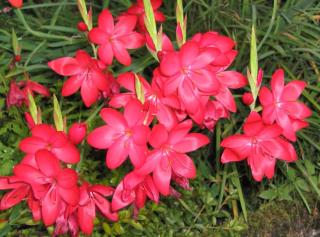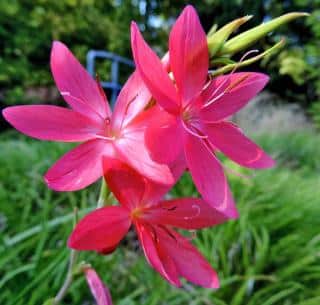

Schizostylis or kaffir lily is a superb flower with winter blooming.
Schizostylis facts, a summary
Name – Schizostylis
Family – Iridaceae
Type – rhizome perennial
Height – 16 to 24 inches (40 to 60 cm)
Exposure – full sun
Soil – rather moist
Flowering – September to February
Take advantage of its cute flowers from September to mid-February.
The most desirable season to plant schizostylis is spring, but it can also be done in fall. If the climate is mild in winter, you can also plant it a bit later.
Avoid planting your Schizostylis in summer because they would undergo stress from the heat.
Proper location and soil to plant schizostylis
Choosing the location and the quality of the soil is primordial in planting kaffir lily. That what determines the blooming and the expected growth of the plant.
How to plant schizostylis
Proper planting ensures beautiful blooming all winter long.
Propagating schizostylis
Schizostylis or kaffir lily is a plant that very easily propagates through rhizome division during the entire vegetation phase.
Once properly settled in, schizostylis is a plant that has little need for care. Schizostylis even tends to propagate on its own around the mother plant.
Watering and fertilizing schizostylis
 If your schizostylis or kaffir lily are properly settled in rich soil that stays cool in summer, you shouldn’t need to intervene too often.
If your schizostylis or kaffir lily are properly settled in rich soil that stays cool in summer, you shouldn’t need to intervene too often.
Thick mulch on the ground helps keep the soil cool and moist which helps avoid many watering sessions.
 Native to South Africa and thus from the Southern Hemisphere, it normally blooms in summer. But since it wasn’t able to shift its blooming pattern to fit the climates in the Northern Hemisphere, it blooms there in winter.
Native to South Africa and thus from the Southern Hemisphere, it normally blooms in summer. But since it wasn’t able to shift its blooming pattern to fit the climates in the Northern Hemisphere, it blooms there in winter.
It thus blooms very late, in fall or even later if the weather isn’t too cold in winter.
Ideal to decorate around bodies of water in your garden, it is also perfectly suited to ordinary soil, provided that it is often watered in summer.
The name Kaffir lily comes from the fact that this admirable flower grows in the wild along brooks and wet zones in a large area of Southern Africa formerly called Kaffraria, the land of the Kaffirs.
At the end of summer, add special flower plant fertilizer to make the blooming even more beautiful and dense.
Thank you for the very helpful advice on planting and growing Schizostytilis lilies. I have just bought one, which is flowering and didn’t realise they bloom in Winter. I have a place for them where I think they’ll be very happy
That’s really swell, Marguerite! Yes, it’s a nice flower for winter blooming. I’m happy the article has been of help. If you have any questions about your Schizostylis, feel free to ask and I’ll look into it.
I am looking to buy river lilies, schizostylis
Hi Santa! They’re native to South Africa so you even have the option of bringing a plant or two if you go on a walk and find them in nature! Neighbors might have them growing, too.
For sure garden stores in the area will have them. Some online shippers also sell these, but Nature & Garden is an editorial site.
Your comment is awaiting moderation.
Your comment is awaiting moderation.